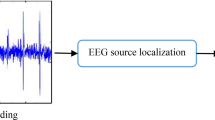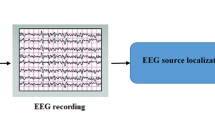Abstract
Emotion recognition using biological brain signals needs to be reliable to attain effective signal processing and feature extraction techniques. The impact of emotions in interpretations, conversations, and decision-making, has made automatic emotion recognition and examination of a significant feature in the field of psychiatric disease treatment and cure. The problem arises from the limited spatial resolution of EEG recorders. Predetermined quantities of electroencephalography (EEG) channels are used by existing algorithms, which combine several methods to extract significant data. The major intention of this study was to focus on enhancing the efficiency of recognizing emotions using signals from the brain through an experimental, adaptive selective channel selection approach that recognizes that brain function shows distinctive behaviors that vary from one individual to another individual and from one state of emotions to another. We apply a Bernoulli–Laplace-based Bayesian model to map each emotion from the scalp senses to brain sources to resolve this issue of emotion mapping. The standard low-resolution electromagnetic tomography (sLORETA) technique is employed to instantiate the source signals. We employed a progressive graph convolutional neural network (PG-CNN) to identify the sources of the suggested localization model and the emotional EEG as the main graph nodes. In this study, the proposed framework uses a PG-CNN adjacency matrix to express the connectivity between the EEG source signals and the matrix. Research on an EEG dataset of parents of an ASD (autism spectrum disorder) child has been utilized to investigate the ways of parenting of the child's mother and father. We engage with identifying the personality of parental behaviors when regulating the child and supervising his or her daily activities. These recorded datasets incorporated by the proposed method identify five emotions from brain source modeling, which significantly improves the accuracy of emotion recognition in comparison with the existing algorithms. The results show a 1% to 2% increase in classification accuracy in absolute terms. Furthermore, an experiment indicates the proposed method performs better than similar methods. We also discovered that the suggested approach performs admirably when using conventional classification techniques.








Similar content being viewed by others
Data availability
No datasets were generated or analyzed during the current study.
References
Gifford C (2020) The problem with emotion-detection technology.
Marrero-Fernández P, Montoya-Padrón A, Jaume-i-Capó A, Buades Rubio JM (2014) Evaluating the research in automatic emotion recognition. IETE Tech Rev 31(3):220–232
Barrett LF, Lewis M, Haviland-Jones JM (eds) (2016) Handbook of emotions. Guilford Publications, New York
Huang D, Guan C, Ang KK, Zhang H, Pan Y (2012) Asymmetric spatial pattern for EEG-based emotion detection. In: The 2012 International Joint Conference on Neural Networks (IJCNN) (pp. 1–7). IEEE.
Michel CM, Murray MM (2012) Towards the utilization of EEG as a brain imaging tool. Neuroimage 61(2):371–385
da Silva FL (2013) EEG and MEG: relevance to neuroscience. Neuron 80(5):1112–1128
Northoff G (2014) Minding the brain. A guide to neuroscience and philosophy. Palgrace MacMillan.
Anderson DK, Lord C, Risi S, DiLavore PS, Shulman C, Thurm A, Pickles A (2017) American Psychiatric Association. (2013). Diagnostic and statistical manual of mental disorders. Washington, DC: Author. The Linguistic and Cognitive Effects of Bilingualism on Children with Autism Spectrum Disorders, 21, 175.
Lu M, Yang G, Skora E, Wang G, Cai Y, Sun Q, Li W (2015) Self-esteem, social support, and life satisfaction in Chinese parents of children with autism spectrum disorder. Res Autism Spectrum Dis 17:70–77
Goetz GL, Rodriguez G, Hartley SL (2019) Actor-partner examination of daily parenting stress and couple interactions in the context of child autism. J Fam Psychol 33(5):554
Hartley SL, Papp LM, Bolt D (2018) Spillover of marital interactions and parenting stress in families of children with autism spectrum disorder. J Clin Child Adolesc Psychol 47(sup1):S88–S99
Sim A, Cordier R, Vaz S, Falkmer T (2016) Relationship satisfaction in couples raising a child with autism spectrum disorder: A systematic review of the literature. Res Autism Spectrum Dis 31:30–52
Wyczesany M, Ligeza TS (2015) Towards a constructionist approach to emotions: verification of the three-dimensional model of affect with EEG-independent component analysis. Exp Brain Res 233:723–733
Liu Y, Fu G (2021) Emotion recognition by deeply learned multi-channel textual and EEG features. Futur Gener Comput Syst 119:1–6
Rahman MA, Hossain MF, Hossain M, Ahmmed R (2020) Employing PCA and t-statistical approach for feature extraction and classification of emotion from multichannel EEG signal. Egypt Inf J 21(1):23–35
Nawaz R, Cheah KH, Nisar H, Yap VV (2020) Comparison of different feature extraction methods for EEG-based emotion recognition. Biocybern Biomed Eng 40(3):910–926
Li Z, Qiu L, Li R, He Z, Xiao J, Liang Y, Pan J (2020) Enhancing BCI-based emotion recognition using an improved particle swarm optimization for feature selection. Sensors 20(11):3028
Liu W, Qiu JL, Zheng WL, Lu BL (2019) Multimodal emotion recognition using deep canonical correlation analysis. arXiv preprint arXiv:1908.05349.
Ren F, Dong Y, Wang W (2019) Emotion recognition based on physiological signals using brain asymmetry index and echo state network. Neural Comput Appl 31:4491–4501
Jäncke L, Alahmadi N (2016) Detection of independent functional networks during music listening using electroencephalogram and sLORETA-ICA. NeuroReport 27(6):455–461
Padilla-Buritica JI, Martinez-Vargas JD, Castellanos-Dominguez G (2016) Emotion discrimination using spatially compact regions of interest extracted from imaging EEG activity. Front Comput Neurosci 10:55
Batabyal T, Muthukrishnan SP, Sharma R, Tayade P, Kaur S (2018) Neural substrates of emotional interference: A quantitative EEG study. Neurosci Lett 685:1–6
Wang F, Wu S, Zhang W, Xu Z, Zhang Y, Wu C, Coleman S (2020) Emotion recognition with convolutional neural network and EEG-based EFDMs. Neuropsychologia 146:107506
Khare SK, Bajaj V (2020) Time–frequency representation and convolutional neural network-based emotion recognition. IEEE Trans Neural Netw Learn Syst 32(7):2901–2909
ArulDass SD, Jayagopal P (2022) Identifying complex emotions in alexithymia affected adolescents using machine learning techniques. Diagnostics 12(12):3188
Plummer C, Harvey AS, Cook M (2008) EEG source localization in focal epilepsy: Where are we now? Epilepsia 49(2):201–218
Pascual-Marqui RD, Michel CM, Lehmann D (1994) Low-resolution electromagnetic tomography: a new method for localizing electrical activity in the brain. Int J Psychophysiol 18(1):49–65
Pascual-Marqui RD (2002) Standardized low-resolution brain electromagnetic tomography (sLORETA): technical details. Methods Find Exp Clin Pharmacol 24(Suppl D):5–12
Grech R, Cassar T, Muscat J, Camilleri KP, Fabri SG, Zervakis M, Vanrumste B (2008) Review on solving the inverse problem in EEG source analysis. J Neuroeng Rehabilit 5(1):1–33
Hallez H, Vanrumste B, Grech R, Muscat J, De Clercq W, Vergult A, Lemahieu I (2007) Review on solving the forward problem in EEG source analysis. J Neuroeng Rehabilit 4(1):1–29
Kiebel SJ, Daunizeau J, Phillips C, Friston KJ (2008) Variational Bayesian inversion of the equivalent current dipole model in EEG/MEG. Neuroimage 39(2):728–741
Mosher JC, Leahy RM, Lewis PS (1999) EEG and MEG: forward solutions for inverse methods. IEEE Trans Biomed Eng 46(3):245–259
Costa F, Batatia H, Chaari L, Tourneret JY (2015) Sparse EEG source localization using Bernoulli laplacian priors. IEEE Trans Biomed Eng 62(12):2888–2898
Robert CP, Casella G, Casella G (1999) Monte Carlo statistical methods, vol 2. Springer, New York
Shuman DI, Narang SK, Frossard P, Ortega A, Vandergheynst P (2013) The emerging field of signal processing on graphs: Extending high-dimensional data analysis to networks and other irregular domains. IEEE Signal Process Mag 30(3):83–98
Schmahmann JD, Doyon J, McDonald D, Holmes C, Lavoie K, Hurwitz AS, Petrides M (1999) Three-dimensional MRI atlas of the human cerebellum in proportional stereotaxic space. Neuroimage 10(3):233–260
Kenny DA, Kashy DA, Cook WL (2006) The analysis of dyadic data.
Gratz KL, Roemer L (2004) Multidimensional assessment of emotion regulation and dysregulation: Development, factor structure, and initial validation of the difficulties in emotion regulation scale. J Psychopathol Behav Assess 26:41–54
Yan J, Han ZR, Li P (2016) Intergenerational transmission of perceived bonding styles and paternal emotion socialization: Mediation through paternal emotion dysregulation. J Child Fam Stud 25:165–175
Abidin RR, Brunner JF (1995) Development of a parenting alliance inventory. J Clin Child Psychol 24(1):31–40
Koelstra S, Muhl C, Soleymani M, Lee JS, Yazdani A, Ebrahimi T, Patras I (2011) Deap: A database for emotion analysis; using physiological signals. IEEE Trans Affect Comput 3(1):18–31
Ackermann P, Kohlschein C, Bitsch JA, Wehrle K, Jeschke S (2016) EEG-based automatic emotion recognition: Feature extraction, selection, and classification methods. In 2016 IEEE 18th international conference on e-health networking, applications, and services (Healthcom) (pp. 1–6). IEEE.
Pane ES, Hendrawan MA, Wibawa AD, Purnomo MH (2017) Identifying rules for electroencephalograph (EEG) emotion recognition and classification. In: 2017 5th International Conference on Instrumentation, Communications, Information Technology, and Biomedical Engineering (ICICI-BME) (pp. 167–172). IEEE.
Romanowicz K, Kozłowska K, Wichniak A (2019) Psychomotor retardation in recurrent depression and the related factors. Adv Psych Neurol/Postępy Psychiatrii i Neurologii 28(3):208–219
Ali MH, Jaber MM, Alfred Daniel J, Vignesh CC, Meenakshisundaram I, Kumar BS, Punitha P (2023) Autonomous vehicles decision-making enhancement using self-determination theory and mixed-precision neural networks. Multimed Tools Appl 1–24.
Funding
The authors did not receive any funding.
Author information
Authors and Affiliations
Contributions
All authors contributed to the design and methodology of this study, the assessment of the outcomes, and the writing of the manuscript.
Corresponding author
Ethics declarations
Conflict of interest
Authors do not have any conflicts.
Code availability
Not applicable.
Additional information
Publisher's Note
Springer Nature remains neutral with regard to jurisdictional claims in published maps and institutional affiliations.
Rights and permissions
Springer Nature or its licensor (e.g. a society or other partner) holds exclusive rights to this article under a publishing agreement with the author(s) or other rightsholder(s); author self-archiving of the accepted manuscript version of this article is solely governed by the terms of such publishing agreement and applicable law.
About this article
Cite this article
ArulDass, S.D., Jayagopal, P. Classifying distinct emotions from parents of ASD child using EEG source data by combining Bernoulli–Laplace Prior and graph neural networks. Neural Comput & Applic (2023). https://doi.org/10.1007/s00521-023-09171-y
Received:
Accepted:
Published:
DOI: https://doi.org/10.1007/s00521-023-09171-y





